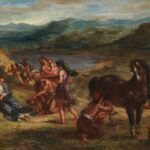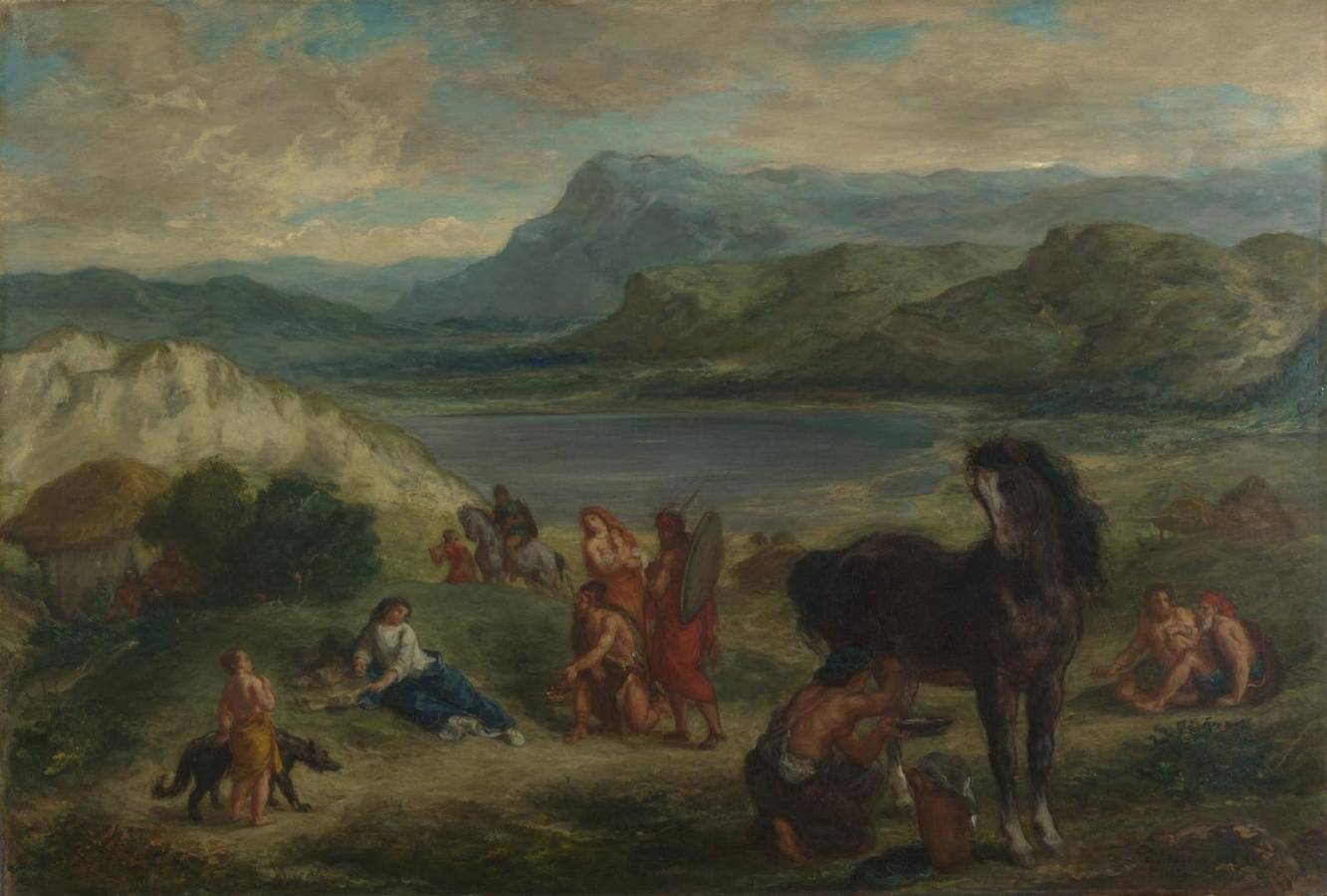Delacroix, Eugène (1798-1863)
Ovide chez les Scythes (Ovid among the Scythians)
1859
Oil on canvas, 87.6 × 130.2 cm
National Gallery, London
In AD 8 the Roman poet Ovid, author of The Art Of Love and the epic poem Metamorphoses, was banished by the Emperor Augustus to the port of Tomis on the coast of the Black Sea, at the frontier of the Roman Empire. The reason for Ovid’s banishment is not known, but, despite his pleas to return to Rome, he died in exile in AD 17/18 aged 74.
Delacroix depicts the kindness shown to Ovid, who lies on the ground dressed in a blue toga. Two shepherds, accompanied by a woman, offer him food and milk. Delacroix includes a variety of figures and responses to Ovid: a young boy with a large dog stares at the poet, a shepherdess milks a large mare, two seated men on the right discuss the scene and two small groups in the mid-distance advance towards him.
The balanced distribution of these figures across the painting echoes the structure of a classical frieze and also recalls the landscapes of Nicolas Poussin such as Landscape with a Man Killed by a Snake (probably painted in 1648). The landscape itself may be based on Delacroix’s recollections from his trip to Morocco in 1832 or upon prints that illustrated accounts of Captain James Cook’s expeditions to the Pacific, which interested Delacroix. Reference to such landscapes beyond Europe, untouched by human intervention, evoked the idea that nature itself could have beneficial effects – a notion that had been popular since the eighteenth century.
Delacroix had previously used Metamorphoses as a source for paintings and had specifically considered the story of Ovid’s exile among the Scythians as early as the mid-1830s, commenting on the parallel between Ovid and Robinson Crusoe. He subsequently depicted Ovid in exile as part of the ceiling decoration he completed in the 1840s at the Palais Bourbon (now the National Assembly) in Paris. Delacroix’s revisiting of the subject the following decade suggests it had personal significance. In particular, two related themes preoccupied him: society’s hostile response to the artist of genius and the contrast between civilisation and barbarism. Delacroix had previously depicted a poet as the victim of the cruel and arbitrary use of power in his two versions of Tasso in the Madhouse painted in 1824 and 1839. In this painting of Ovid, however, Delacroix does not focus on the act of banishment itself or on Ovid’s suffering. Instead, he depicts the hospitality of the Scythians. Not only is the response of the ‘barbarous’ Scythians to Ovid implicitly contrasted with the cruelty of his treatment by ‘civilised’ Rome, but nature, as a realm beyond civilisation, is less a place of punishment than a potential source of regeneration.
Delacroix exhibited this painting in the Salon of 1859 where it was well-received, despite some questioning of the proportions of the figures and the mare. The critic and poet Charles Baudelaire (1821–1867), who had always championed Delacroix’s art, asserted that, ‘it is one of those wonderful works such as Delacroix alone can conceive and paint.’ (NG)
Compare:
 Delacroix, Eugène (1798-1863)
Delacroix, Eugène (1798-1863)
Ovide chez les Scythes
1862
Metropolitan Museum of Art, New York
See also:
• Ovid (43 BC-17/18 AD)
